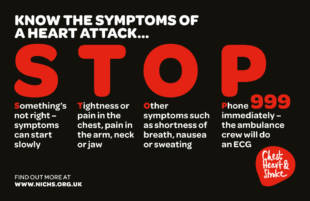Finding out you have a long–term heart condition can be very frightening.
Without the right information, skills and confidence it can be hard for people with a heart condition to manage their health.
For those affected and their families, the right knowledge, skills and services can make a real difference. We have a team of experienced and compassionate people who are here to help.
Looking back, I was probably having a heart attack while waiting in the pharmacy to pay for a heartburn remedy, but at the time I was convinced it was indigestion.
-
Your heart is a muscular pump about the size of your clenched fist and it circulates blood to every part of your body. The average heart beats 100,000 times a day.
The heart has a left and right side, and these two sides of the heart have separate functions. The right side of the heart collects blood low in oxygen from the body and pumps it to the lungs, where it picks up oxygen and releases carbon dioxide.
The left side of the heart then collects blood rich in oxygen coming from the lungs and pumps it to the body via the aorta and a series of arteries. Once the oxygen is delivered to the cells in your body, the blood flows back to the right side of the heart through a series of veins.
Like any muscle, your heart requires both blood and oxygen to work properly. The right and left coronary arteries carry blood to the heart muscle to ensure that it gets enough oxygen and other nutrients.
-
Angina is the pain or discomfort experienced when the heart muscle doesn’t get as much oxygen as it needs, due to the build-up of fatty deposits (plaque) on the walls of the arteries. It is a common warning sign of coronary heart disease.
Symptoms of angina can include:
- Pressure or a feeling of tightness in the chest
- This pain can also be felt at the same time in the neck, jaw and left arm, or both arms
- Sometimes it extends to the upper back and shoulders
- Pain may be accompanied by breathlessness and sweating
Angina most commonly occurs during or immediately after physical exertion. It may also occur during times of stress or strong emotion like anger or excitement, which cause your heart rate to increase. Some people also report that angina develops more easily in cold temperatures and windy weather or after large meals. If you notice pain or pressure in your chest when you exert yourself, you should visit your GP as soon as possible. The doctor will ask you a number of questions about the pain, such as:
- What brings on the pain or discomfort and what relieves it?
- What does the pain or discomfort feel like (for example, heaviness or tightness)?
- How often does it occur?
Your GP will also listen to your heart and chest and check your blood pressure. If your doctor suspects that you have angina, you may be referred to the hospital for more heart tests such as:
- An ECG (Electrocardiogram)
- An Exercise Stress Test
- An Echocardiogram
- An Angiogram
Managing Your Angina
Managing angina may involve lifestyle changes, medication, medical procedures, and cardiac rehabilitation.
Lifestyle changes and medicines may be the only treatments needed if your symptoms are mild and aren’t getting worse. After several episodes, you will know the level of activity, stress, or other factors that bring on your angina. This knowledge enables you to take steps to prevent or lessen the severity of episodes.
When lifestyle changes and medicines don’t control angina, you may need medical procedures and/or cardiac rehabilitation.
-
A heart attack, also known as myocardial infarction, occurs when an artery becomes blocked. Coronary heart disease is one of the leading causes of heart attack. It causes a build–up of fatty deposits (plaque) on the walls of the coronary arteries, which narrows them. These fatty deposits can then rupture and trigger the formation of a blood clot.
A blockage may also result from a spasm or sudden narrowing of a coronary artery. As a result, the heart muscle is starved of oxygen and may be permanently damaged.
The symptoms of a heart attack vary from person to person but may be characterised by the acronym STOP:

STOP is an acronym for:
S – Something’s not right – symptoms can start slowly
T – Tightness or pain in the chest, pain in the arm, neck or jaw
O – Other symptoms such as shortness of breath, nausea or sweating
P – Phone 999 immediately – the ambulance crew will do an ECG.
The last letter of STOP is very important – phone 999 immediately. There’s no time to waste when chest pain strikes. Every minute that passes can mean the difference between life and death. Our advice is to call 999 rather than driving the patient to hospital, because the ambulance crew can provide treatment at the scene
Unlike angina, pain associated with a heart attack is not usually relieved by rest or nitrate sprays, such as GTN (Glyceryl Trinitrate).
Geoff's Story
Heart Attack Diagnosis and Treatment
A heart attack is usually confirmed with heart tests such as an electrocardiogram (ECG) and blood tests. The ECG may be done by the ambulance crew. Treatments to try to restore blood flow to the heart are started as soon as possible.
Initial treatment will include pain relief, oxygen and a combination of medications to thin the blood, widen the blood vessels or slow down the heartbeat.
During a hospital stay, ECGs and blood tests are carried out. Other tests may also be conducted to assess how well the heart is pumping, whether blood flow has been restored and to help decide on the best form of treatment. Click here to find out more information on the types of tests which may be carried out.
Treatment
Medications – After a heart attack, you may need to take a variety of medicines. The aim of administering medication during a heart attack, and just after, is to restore blood flow, save heart tissue and prevent complications. The purpose of subsequent medication is to promote healing of your heart and prevent another heart attack.
Primary Percutaneous Coronary Intervention (PPCI) – This procedure improves blood flow to the heart by using a special balloon to open a blocked artery from the inside. Often a special expandable metal tube (stent) is inserted and left in place to keep the artery open.
PPCI treatment is now available 24/7 across Northern Ireland. When the ambulance crew arrives, they will carry out an ECG on the patient which they forward to the specialist nurse teams at the RVH or Altnagelvin, which are Northern Ireland’s Heart Attack Centres (HACs). This highly specialist triage team then decide if the type of heart attack the patient is experiencing needs PPCI at one of the HACs or if they can be taken to their local A&E. If they are suitable for PPCI, the ambulance crew will take the patient directly to the Cath Lab for treatment, bypassing A&E. Their chance of survival are increased and their chances of reoccurrence are reduced. This is why it is important to call 999 immediately – the sooner this process starts, the better chance the patient has of a good recovery.
Coronary artery bypass graft (CABG) – Increasingly, blockages are being opened up with PCI but there are still cases where surgery is needed. In CABG, healthy arteries or veins taken from other areas in the body are used to bypass narrowed coronary arteries.
Recovery from a heart attack
Recovery after a heart attack will start slowly. For the first few days you will need bed rest but gradually you will become more active, based on advice from your doctor. Structured cardiac rehabilitation programmes start in hospital. Cardiac rehabilitation is a programme to help people manage their heart condition and improve their health. Cardiac rehabilitation has two parts:
Exercise training – Teaches you how to exercise safely, strengthen muscles, and improve stamina.
Education – This part of the programme develops understanding about heart conditions and ways to reduce the risk of future heart problems.
It can also help to meet other people who have had similar experiences. Both Northern Ireland Chest Heart and Stroke and the Cardiac Support Network have a number of support groups across Northern Ireland, more details of which can be found by clicking here.
-
Cardiac arrest is when the heart goes into spasm and stops beating. This can happen for a number of reasons. For example, during a heart attack, a complication called ventricular arrhythmia can cause the heart to go into spasm and then to stop beating. It can also be caused by a congenital heart defect or by an external event such as electrocution, choking or trauma.
Signs and symptoms suggesting a person has gone into cardiac arrest include:
- They appear not to be breathing
- They are not moving
- They do not respond to any stimulation, such as being touched or spoken to
If you think somebody has gone into cardiac arrest:
- phone 999
- use a defibrillator, if available
- do CPR
When you phone 999 the operator will be able to tell you what to do. If you are unable to restart the person’s heart, CPR will at least keep the blood, containing oxygen, flowing around the patient’s body until an ambulance arrives.

“I had none of the lifestyle factors that normally put someone at risk....You have to be aware that it could happen to you."
-
Heart failure means that your heart is not able to pump blood in the way it should. The most common cause of heart failure is a heart attack, which causes damage to the muscle of the heart. Common causes of chronic (long–term) heart failure include:
- Coronary heart disease
- High blood pressure
- Cardiomyopathy (disease of the heart muscle)
- An irregular heartbeat
- Disease of the heart valves
- Thyroid gland disease
- Alcohol or substance abuse
All these conditions put extra strain on the heart over a long period of time. The heart initially tries to cope with the extra workload by getting bigger, developing more muscle or beating faster in an attempt to keep up with demand. But eventually it cannot cope and when it starts to fail symptoms will become evident. Not everyone experiences the same symptoms, but you might feel short of breath when you are physically active. For some people this happens even when they are at rest. You may feel very tired, or have swollen feet and ankles. If you have had a serious heart attack the symptoms may develop suddenly but they can also develop over weeks, months or longer.
Diagnosis of heart failure
If you are feeling very tired or breathless or have noticed your ankles and feet being swollen, you should visit your GP. The doctor will ask you a number of questions about your symptoms and medical history. Your GP will also listen to your heart and chest and check your blood pressure. If your doctor suspects that you have heart failure, you may be referred to hospital for more heart tests such as:
- An ECG (Electrocardiogram)
- An Echocardiogram
- A chest x–ray
- Blood tests
Managing heart failure
Managing heart failure may involve lifestyle changes, medication or medical procedures. It is important that you monitor your symptoms and learn to recognise changes in their pattern. Changes in symptoms may be a sign that your heart failure is worsening, so you should see your GP.
For example, fluid retention leads to weight gain and can be an indication of accelerating heart failure or that your medications need to be adjusted. You can monitor this by weighing yourself at the same time each morning.
When lifestyle changes and medicines don’t control your heart failure, you may need a medical procedure. There are some forms of surgery and some devices which can be implanted in the body that can help some people with heart failure. However, medical interventions are not suitable for everyone and will be recommended only after tests.
“When the doctors told me I had heart failure, I thought my heath would just start deteriorating bit by bit.”
- Rowley, Living with Heart Failure (wife wife Brenda)

Find out more about our Cardiac Support Services. -
Your heart has a natural pacemaker called the sinus node, which sends electrical impulses through special fibres in the heart muscle to stimulate it to beat. These electrical impulses usually keep it in a regular ‘sinus’ rhythm. Your heart will normally beat between 60 and 100 times a minute when you are resting. Each heartbeat can be shown on a heart tracing, called an electrocardiogram or ECG. At one time or another, most people have felt their heart race or skip a beat. These occasional changes can be brought on by strong emotions, exercise, caffeine or alcohol and they are usually not a cause for alarm.
An arrhythmia is a change in the rhythm of the heart. The heart rate can become abnormally fast, slow and/or irregular. Most arrhythmias are harmless, but some can be serious. When the rate is too slow, too fast or irregular, the heart may not be able to pump enough blood around the body. When this occurs it needs to be investigated and treated. You may not notice any symptoms of an arrhythmia. If you do have any, they will depend on the type of arrhythmia you have and how severe it is. Symptoms may include:
- Palpitations or a fluttering in your chest
- Dizziness
- Fainting or collapsing
- Breathlessness
- Chest pain
Diagnosis of Arrhythmia
If you have noticed repeated palpitations or a fluttering in your chest you should visit your GP. The doctor will ask a number of questions about your symptoms, such as what they feel like, when and how often they occur. Your GP will also listen to your heart and feel your pulse. If he or she suspects that you have an arrhythmia you may be referred to hospital for further tests, such as:
- An ECG (Electrocardiogram)
- An Exercise Stress Test
- Ambulatory Monitoring
If the palpitations are very persistent and not responding well to medication, electrophysiological studies (EPS) may be needed to investigate their cause fully.

"When I was diagnosed with Atrial Fibrillation, I wasn’t particularly worried. I didn’t know it was possible I could have a stroke."
- Rosaleen, Living with Atrial Fibrillation
Find out more about Atrial Fibrillation, a type of Arrhythmia, here.
-
An artificial pacemaker is an electronic device placed under the chest skin to help the heart maintain a regular rhythm. The pacemaker system includes a pulse generator and electrical leads that connect the pulse generator to the heart.
Pulse generator – this small metal container contains a long life battery and the electrical circuitry that monitors your underlying heart rhythm. It regulates the rate of electrical pulses sent to your heart.
Leads– these flexible, insulated wires deliver the electrical impulses to your heart. Most pacemakers work only when they are needed or upon demand. This means that the pacemaker sends out an impulse only when it detects that the heart has missed a beat or is beating too slowly. If the pacemaker senses no natural beat, it will pace continuously.
Implantation
The pacemaker is implanted during a minor surgical procedure performed under local anaesthetic and light sedation. The leads are placed through a vein beneath the collarbone and positioned in the heart under x–ray. Tests are carried out to ensure the leads are well connected to the heart muscle. The leads are then connected to the pulse generator, which is placed beneath the skin just below the collarbone. Usually only a small bump in the skin is seen at the site where the pacemaker has been implanted. The procedure usually takes less than an hour.
After Implantation
Recovery from the procedure is rapid although for several weeks there will be restrictions on heavy lifting and extreme motion of the arm on the side where the pacemaker is implanted. You may experience some discomfort and bruising around your pacemaker site for a few days but this can be eased with pain–relieving medication. Before you go home a nurse will advise you on how to care for the pacemaker site, including keeping it dry for one week. Most patients return to normal activities within a few days. You may need time to get used to the pacemaker in general. You may be aware of the presence of the pulse generator but you will soon become used to it. After the pacemaker is implanted, regular follow–ups will be scheduled. At each visit the pacemaker will be tested and the life of the battery monitored. If necessary the pacemaker programme will be adjusted to your individual needs.
-

Joe Degnan was born with congenital heart disease and underwent his first heart surgery at only 6 days old.
Congenital heart disease means heart disease that affects a person from birth. It is the most commonly occurring serious congenital abnormality affecting children. It happens all over the world, in families from all walks of life.
The heart is made up of four main sections called chambers, with four valves controlling how the blood flows between these chambers and around the body. Congenital heart disease occurs when one or more of these chambers or valves does not develop properly in the womb.
Worldwide, there were 223,000 deaths caused by the condition in 2010. In Northern Ireland alone, over 200 babies are born with congenital heart disease every single year. Of these, 50 will require cardiac surgery in the first year of life and more will require interventional cardiac catheterisation and other treatments.
Thankfully, due to advances in surgery and other treatments, most children do very well and have an excellent quality of life. But some survivors of congenital heart disease can continue to have problems through to adulthood. An increasing number of young adults require further surgical treatment and lifelong follow–up care.
In most cases, we don’t know why babies are born with congenital heart disease.
We know that some genetic and environmental factors can be involved but the majority of cases remain unexplained.
Congenital heart disease – the facts:
- Congenital heart disease is the most commonly occurring serious congenital abnormality affecting children.
- Congenital heart disease is one of the most common birth defects and affects 8–10 of every 1,000 babies.
- In Northern Ireland, over 200 babies a year are born with congenital heart disease.
The Baby Hearts Study is a pioneering research project funded by Northern Ireland Chest Heart & Stroke (NICHS) which aims to pinpoint the causes of congenital heart disease. Find out more by clicking here.
-
Heart tests give doctors important information about your heart which can be used to determine the best treatment for your condition. Heart tests include:
- Electrocardiogram (ECG)
- Exercise Stress Test
- Ambulatory Monitoring
- Echocardiogram (ECHO)
- Cardiac Catheterisation
Electrocardiogram
An electrocardiogram (ECG) is a quick, painless test that measures the electrical activity and rhythm of your heart. The ECG will show a variety of lines and waves which will be analysed to see if there is reduced blood flow to the heart muscle or if you have had any recent damage to the heart. The ECG will also show how fast your heart is beating and any irregularities in its rhythm. Sometimes your doctor will compare your current ECG to previous ones. This helps to determine if changes to your electrocardiogram are recent. Since the ECG has limitations, your doctor may refer you on for further tests.
Exercise Stress Test
For many people who have significant narrowing of the arteries supplying the heart muscle, the electrocardiogram (ECG) recording made at rest can be normal. An Exercise Stress Test is an ECG recording made while the patient is exercising to see if their heart rate and rhythm is affected by activity or stress. During an exercise stress test you will walk on a treadmill while your ECG and blood pressure are monitored and recorded. The doctor will be looking at the ECG to see if any changes indicate coronary heart disease. The doctor will also be interested in how much exercise you are able to do and whether you experience chest pain or breathlessness.
Ambulatory Monitoring
Ambulatory monitoring involves monitoring your heart while you go about your normal daily activities. You will be asked to wear a small portable monitor at home.
A Holter monitor records the electrical activity of your heart while you do your usual activities. It is a small, portable ECG machine worn at home over a 24–48 hour period. Many symptoms like palpitations or fluttering in your chest become noticeable only during exercise, eating, stress, or even sleeping. A continuous recording is more likely to detect any abnormal heartbeats or rhythms that occur during these activities.
A Patient Activated Event Recorder is a device which records the ECG if you push the button when you feel your symptoms. This type of monitor may be more appropriate if your palpitations or fluttering sensations are less frequent.
Echocardiogram
An echocardiogram (echo) is a test in which ultrasound is used to examine the heart. The echo produces an image of the heart on a screen. It shows the structures of your heart including the 4 chambers and the valves. It assesses how well your heart is pumping, the presence of fluid around it, problems with your heart valves and information about the pressures within your heart.
A Transoesophageal Echocardiogram (TOE) is a special type of echocardiogram used when a closer and more defined image of the heart valves is needed. Pictures of your heart are taken by inserting a probe into your gullet (oesophagus). These pictures are clearer because the oesophagus is close to your heart and the chest wall is not in the way. The back of your throat will be sprayed with some numbing solution and although you will be awake during the procedure, you will be given some medication to make you feel relaxed and sleepy.
Cardiac Catheterisation
Cardiac catheterisation, also known as an Angiogram,is a procedure in which a small plastic tube is placed within a large artery in your groin and fed to the arteries in your heart. A special contrast agent (dye) will then be injected through the catheter and a series of x–rays will be taken. This technique is used to take pictures of the coronary arteries and the pumping action of the heart. It provides the most detailed and accurate information on the condition of your coronary arteries. Local anaesthetic is given in your groin or wrist before insertion of the catheter. You may feel pressure as the tube is inserted, as well as a warm sensation throughout your body when the dye is injected. The procedure generally lasts for less than 30 minutes. Afterwards you will be asked to lie still for 3–4 hours to allow the puncture site in the groin to heal (this is only if the groin is used).
Electrophysiological Studies (EPS)
If you have abnormal heart rhythms (arrhythmia) or palpitations you may be referred for this test. As with an angiogram, fine tubes (electrode catheters) are fed into a vein and/ or artery, usually in the groin. They are then gently moved into the heart, where they stimulate the heart and your heart’s electrical activity is recorded. This helps the doctors determine why you have the abnormal rhythm and decide on the best form of treatment.
Download our Heart Conditions Factsheets:
-
Heart Conditions FactsheetDownload pdf
-
Cardiac Arrest FactsheetDownload pdf
Please note that the information on this website is not a substitute for the advice your doctors or other health care professionals may give you based on their knowledge of your condition.

